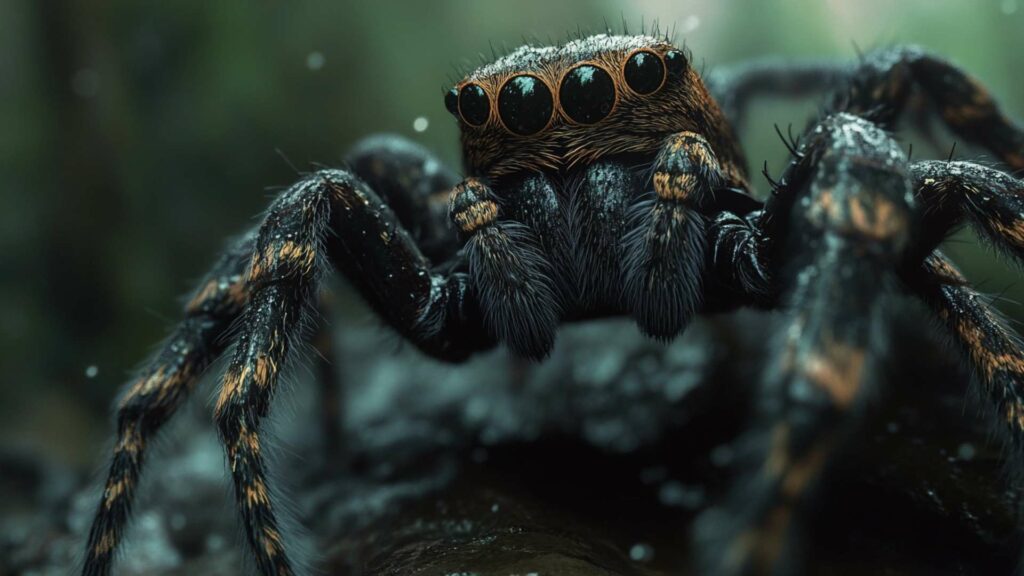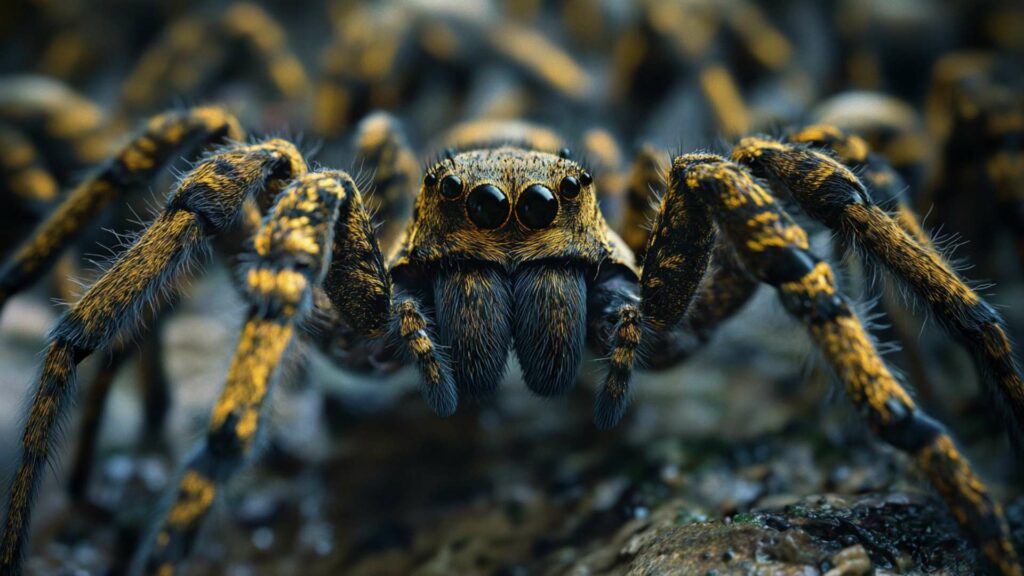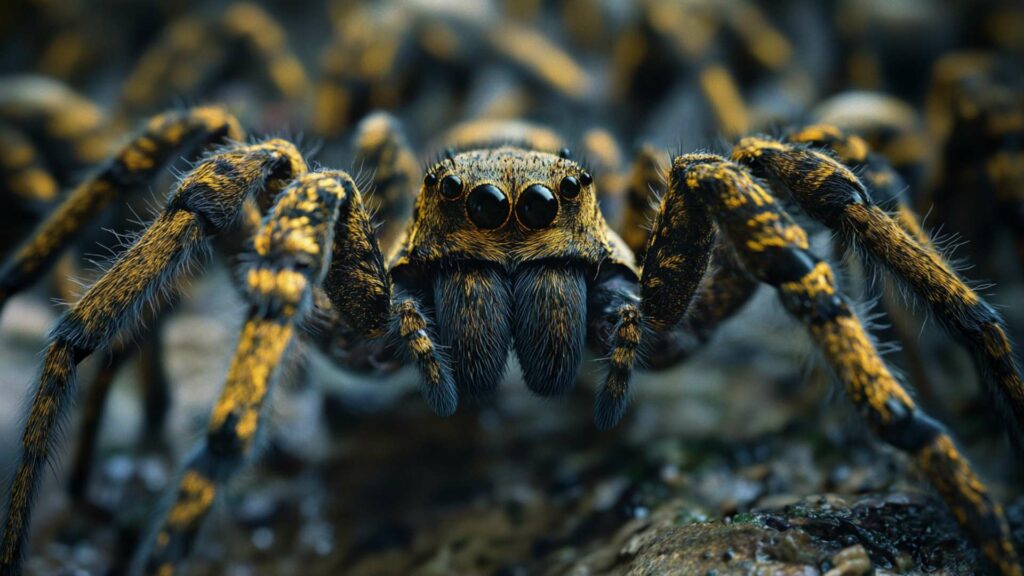Welcome to the fascinating world where spiders eat insects and butterflies coexist, a realm of intricate interactions and natural wonders. The mere thought of these delicate winged creatures encountering the cunning predators known as spiders piques our curiosity about the spider’s diet. How do these arachnids catch butterflies?
Do spiders really eat butterflies? Let us embark on a captivating journey to uncover the secrets of this predator-prey relationship.
Fascinating World of Spiders and Butterflies
Spiders and butterflies are both mesmerizing creatures that captivate our imagination. Butterflies, with their vibrant colors and graceful flight, symbolize beauty and transformation.
They flutter through gardens, delicately pollinating flowers as they seek nectar. Meanwhile, spiders weave intricate webs, showcasing their remarkable silk-spinning abilities.
Their sticky traps are designed to ensnare unsuspecting prey – even monkeys have been caught in some spider webs! These two diverse creatures represent different aspects of the natural world, one enchanting with its gracefulness while the other enthralls us with its cunning nature.
Curiosity about Spider’s Diet
The question that often arises in our minds is whether spiders truly catch and consume butterflies or if this notion is just another figment of imagination. While it may seem improbable that a delicate butterfly could fall prey to a seemingly fragile spider, reality paints a different picture. Spiders are renowned for their predatory skills; they possess an array of strategies to capture insects efficiently.
As we delve deeper into the spider’s diet, we’ll discover that their culinary preferences extend far beyond small bugs caught in sticky webs. While it is true that most spiders primarily feed on insects like moths or other insects drawn into their webs, certain species of crab spiders have evolved specific hunting techniques to catch butterflies directly.
The interactions between spiders and butterflies are not restricted to the spider’s web alone. Some spiders, such as the clever jumping spiders, actively stalk their winged prey.
They rely on their incredible agility and remarkable eyesight to launch lightning-fast attacks, pouncing on unsuspecting butterflies with precision. Understanding the spider’s diet is not merely a matter of biological curiosity; it has broader implications for the delicate balance of ecosystems.
By unraveling the mysteries of spider-butterfly interactions, we can gain insights into predator-prey relationships and the impact of predation on butterfly populations. So, let us embark on this enthralling journey through webs and wings, exploring how these diverse creatures coexist in nature’s grand tapestry.
Spider’s Diet: An Overview

The Many Appetites of Spiders
Spiders, those eight-legged marvels of the arachnid world, are renowned for their remarkable ability to weave intricate webs and capture unsuspecting prey. When it comes to their diet, spiders exhibit a diverse range of feeding habits that vary based on their species and size.
While some spiders are opportunistic hunters seeking any insect that falls into their trap, others employ more active hunting strategies to pursue specific prey. Let us delve deeper into the fascinating world of spider diets.
A Feast Fit for a Predator
The menu of a spider is an extensive one. These carnivorous insects have adapted over millions of years to consume a wide variety of prey species, ensuring they never go hungry.
From small flies and moths fluttering by to other butterflies innocently sipping nectar from flowers, spiders have developed various techniques to catch these delectable morsels. One common hunting method employed by spiders is the construction of intricate webs designed to ensnare unsuspecting insects eating butterflies that dare venture too close.
These silken traps act as both fishing nets and dining halls for our arachnid friends. Be it smaller insects like flies or even larger butterflies; if they find themselves entangled in the sticky threads, they become an unwitting meal for the patient spider lurking nearby.
Web or No Web: The Hunting Styles

Not all spiders rely solely on webs as their primary means of acquiring sustenance. Some species exhibit extraordinary agility and speed when hunting down prey on foot—an airborne butterfly’s worst nightmare! Jumping spiders are champions at this game, utilizing exceptional eyesight and impressive reflexes as they pounce upon butterflies with precision and grace.
Additionally, there are certain spider families known as ambush predators. These crafty hunters camouflage themselves in their surroundings while patiently waiting for an unsuspecting butterfly to come within striking distance.
These spiders skillfully blend into the foliage, biding their time until the perfect moment to strike. Once in range, they launch themselves with lightning-fast speed, capturing their prey in a swift and deadly embrace.
The Vital Organs of a Spider’s Feast
Once caught in the spider’s clutches, the prey meets its fate. Spiders have specialized mouthparts called chelicerae equipped with fangs that inject venom into their victims’ bodies. This venom not only subdues struggling insects but also begins the process of digestion by breaking down vital organs into a more palatable form for consumption.
Unlike humans who primarily taste food through our tongues, spiders have taste receptors on their legs that allow them to evaluate whether potential prey is suitable or not before indulging. This discerning palate helps ensure they do not waste energy on unappetizing meals or risk consuming potentially harmful organisms.
Intriguingly, while some spiders feast on butterflies without hesitation, others have developed an aversion to these winged wonders due to defensive mechanisms present within certain species of butterflies. Some butterflies taste bad or release chemicals when attacked as a deterrent against predators like spiders.
Thus, even within the spider kingdom, preferences and tastes vary from species to species. The spider’s diet is an intricate tapestry woven from threads of opportunity and adaptation.
From weaving intricate webs to employing stealthy hunting strategies or evading unpalatable prey, spiders have carved out a niche as formidable predators in nature’s grand tapestry. So next time you encounter a spider spinning its web or lurking among leaves, take a moment to appreciate its role as both weaver and hunter—a true marvel of nature’s design.
Butterflies as Spider Prey: The Basics

Spiders’ ability to capture butterflies
When we think of spiders, we often picture them spinning intricate webs to entrap unsuspecting insects. While this may be true for some spider species, not all have the same approach when it comes to capturing their prey.
When it comes to butterflies, spiders have developed remarkable abilities that allow them to successfully catch these delicate creatures. One of the main adaptations that enables spiders to capture butterflies is their silk production.
Spiders create sticky webs made of specialized silk strands, which are strategically placed in areas where butterflies are likely to pass by. As a butterfly flies into the web, it becomes entangled in the sticky threads, making escape difficult.
This gives the spider a distinct advantage in capturing its prey. Additionally, certain spider species possess incredible speed and agility that enables them to actively hunt down butterflies without relying on webs alone.
Jumping spiders, for instance, are known for their remarkable leaping abilities and acute vision. These agile hunters will stalk their butterfly prey before pouncing with lightning-fast precision.
Factors Influencing spider-butterfly Interactions
The interaction between spiders and butterflies is influenced by several factors that shape their relationship in nature. One crucial factor is the size disparity between these two creatures. Butterflies are generally larger than most spider species and possess vibrant colors and patterns that make them visually appealing targets for predators like spiders.
However, not all butterfly species fall victim to spiders equally. Some butterflies have evolved defense mechanisms such as wingspans that make it harder for spiders to capture them effectively.
Additionally, certain butterfly species have evolved behaviors like rapid flight or erratic movements during flight that can confuse or discourage potential predators. Environmental factors also play a significant role in shaping spider-butterfly interactions.
The presence of suitable habitats with abundant flowers attracts both butterflies and their spider predators. For example, open meadows and gardens teeming with nectar-rich flowers act as prime locations where the paths of butterflies and spiders frequently intersect.
Furthermore, seasonality and geographical location can influence the prevalence of these interactions. In warmer regions with higher butterfly diversity, spiders may encounter more opportunities to prey upon butterflies.
Conversely, in cooler climates or during winter months when butterfly populations decrease or migrate, spider predation on butterflies may be less common. It is important to note that spiders are not the only natural predators of butterflies.
Birds, wasps, beetles, and even frogs also feed on these delicate creatures. The complex web of predator-prey relationships in nature ensures a balance that prevents any single species from dominating entirely.
Understanding these basics surrounding how spiders capture butterflies and the factors that influence their interactions sheds light on the intricate dynamics within ecosystems. It highlights both the remarkable adaptations of spiders and the constant pressure faced by butterflies to deter predators while carrying out their essential roles as pollinators amidst nature’s diverse tapestry.
Spider Species That Eat Butterflies
Highlighting specific spider families known for preying on butterflies
When it comes to the world of spiders, it’s fascinating to explore the diverse range of many species of prey they consume. While most spiders are generalist predators, there are certain species and families that exhibit a particular fondness for butterflies. These predatory arachnids have developed unique adaptations and techniques to capture and feast upon these delicate winged creatures.
One group of spiders renowned for their butterfly-catching abilities is the orb-weaving spiders (family Araneidae). These remarkable arachnids construct intricate webs with radial threads and sticky spiral capture lines, creating a deadly trap for unsuspecting insects.
Orb-weaving spiders employ their expert silk-spinning skills to create large, beautifully woven webs that glisten in sunlight. When a butterfly flies into this web, vibrations alert the spider to its presence, quickly ensnaring its prey with precision and speed.
Another group of skilled butterfly hunters is the jumping spiders (family Salticidae). Unlike orb weavers that rely on passive hunting strategies, jumping spiders actively pursue their prey.
These agile hunters possess incredible vision thanks to their large front-facing eyes. They use this excellent eyesight to identify butterflies from afar, tracking their movements meticulously.
Once within striking distance, jumping spiders pounce on butterflies with impressive accuracy and dexterity. Jumping spiders are known for their unique hunting behaviors; they engage in strategic fly stalking maneuvers while keeping a safe distance from potential danger.
They patiently wait until an opportune moment presents itself before launching an ambush attack on unsuspecting butterflies. This combination of stealthy movement and swift reflexes makes them formidable predators capable of capturing even the most elusive butterfly species.
It’s important to note that not all spider families specifically target butterflies as part of their diet. While orb-weaving and jumping spiders exhibit remarkable adaptability to hunting butterflies, other spider families may prefer smaller insects such as flies, beetles, or even other spiders.
Nonetheless, the predatory habits of orb-weavers and jumping spiders who eat monarch butterflies demonstrate the incredible diversity of strategies that have evolved within the spider world. Understanding these specific spider species that eat butterflies sheds light on the intricate dynamics between predators and their prey.
Through their unique hunting techniques and adaptations, orb-weaving and jumping spiders have become experts at capturing butterflies in their own distinctive ways. The coexistence of these carnivorous insects and delicate butterflies adds depth to our understanding of ecological relationships in nature.
Butterfly Defense Mechanisms Against Spiders
Fooling the Eyes: Camouflage and Mimicry Techniques

Butterflies, with their intricate wing patterns and vibrant colors, have evolved remarkable defense mechanisms to outsmart their predators. One of these strategies is camouflage, where butterflies blend seamlessly into their surroundings.
Some species have wings that resemble the leaves they rest on, making it difficult for spiders to detect them. By fooling the eyes of their would-be predators, butterflies increase their chances of survival.
In addition to camouflage, butterflies also employ mimicry as a means of defense against spiders. Certain butterfly species mimic the appearance or behavior of toxic or unpalatable creatures such as birds or even monkeys.
By imitating these intimidating animals, butterflies send a clear message to spiders that they are not worth pursuing as prey. This clever trickery helps them avoid becoming a tasty meal for carnivorous insects like spiders.
Chemical Defenses: Making Spiders Think Twice
Apart from visual tricks, some butterflies possess chemical defenses that make them unappetizing or even toxic to spiders and other potential predators. These defensive chemicals can be found in various parts of a butterfly’s body, such as its wings or abdomen. When attacked by a spider, certain butterfly species release noxious substances that taste bad and deter further predation attempts.
These deterrents discourage spiders from pursuing their intended meal any further and teach them to associate butterflies with an unpleasant taste experience. Furthermore, some butterfly caterpillars develop mutualistic relationships with ants as an additional line of defense against spider attacks.
Through glandular secretions or other means of communication, monarch caterpillars attract ants that protect them from spider predation in exchange for sugary secretions or shelter. Overall, the combination of visual deception through camouflage and mimicry techniques along with chemical defenses has allowed butterflies to adapt and escape the clutches of their eight-legged predators in the intricate dance of survival.
Nature never ceases to amaze us with its intricate relationships and survival strategies. The ongoing battle between spiders and butterflies showcases the creative ways in which prey species have evolved to evade becoming a spider’s meal. Through camouflage, mimicry, chemical defenses, and even mutually beneficial partnerships with ants, butterflies have developed an arsenal of tactics that foil spider predation attempts.
Understanding these defense mechanisms not only sheds light on the fascinating world of insects but also highlights the delicate balance within ecosystems. The interplay between predators and prey is not solely about survival; it influences population dynamics, biodiversity, and ultimately shapes our natural world.
As we marvel at the beauty of butterflies fluttering among flowers or admire the skill of spiders weaving intricate webs, let us also appreciate the hidden battles taking place beneath our gaze. Nature’s tapestry is woven with threads of deception, adaptation, and evolution — a testament to its endless resilience and wonder.
Rare Instances: Unusual Spider-Butterfly Interactions
Examples of rare spider species specialized in hunting butterflies
In the vast realm of spider-butterfly interactions, there exist some remarkable cases where certain spider species have developed intricate techniques to hunt butterflies. Two fascinating examples are the bird-dropping spider and the elusive ogre-faced spider.
The stunning bird-dropping spider and its unique butterfly-catching technique

The bird-dropping spider, scientifically known as Celaenia excavata, is not your typical predator monarch butterflies. With its inconspicuous appearance resembling a fresh bird dropping, it skillfully deceives unsuspecting butterflies into approaching closely. This cunning arachnid sets up camp on leaves or branches and patiently waits for a butterfly to approach.
Once within striking distance, the bird-dropping spider swiftly captures its prey with lightning-fast reflexes. What makes this interaction intriguing is the mimicry employed by this particular spider species.
By resembling a repulsive substance to other creatures—humans included—the bird-dropping spider gains an advantage. Its disguise effectively deters predators who might otherwise consider it as potential food while simultaneously attracting curious butterflies that mistake it for a safe perch.
The elusive ogre-faced spider, a stealthy predator of nocturnal butterflies

When it comes to nighttime butterfly hunting, one noteworthy character emerges—the ogre-faced spider (Deinopis spp.). These small mammals’ agile predators possess remarkable vision that aids them in capturing their fluttering prey under cover of darkness. With exceptional eyesight adapted for low light conditions, ogre-faced spiders weave their unique webs between their elongated front legs.
Resting upside down beneath this horizontal net—a true marvel of engineering—the spiders patiently wait for nocturnal butterflies to venture near. Once an unsuspecting butterfly becomes entangled in the web built specifically for catching these delicate creatures, the ogre-faced spider swiftly strikes, immobilizing its prey with a venomous bite before consuming it.
These interactions showcase the remarkable adaptations that certain spider species have developed to secure butterflies as a food source. While most spiders rely on sticky webs to capture their prey, the bird-dropping spider and the ogre-faced jumping spider both display exceptional hunting strategies tailored specifically for catching butterflies.
Although spiders generally consume a wide range of prey, including butterflies, certain species have evolved unique methods to target these delicate insects. The bird-dropping spider deceives its potential victims by resembling an unappealing substance, while the ogre-faced spider displays exceptional vision and web-building skills to capture nocturnal butterflies.
These rare instances of specialized predation demonstrate the incredible diversity and adaptability found within the world of spiders. So next time you delve into nature’s intricate tapestry, spare a thought for these remarkable arachnids and their peculiar relationship with butterfly delicacies.
Ecological Implications
The Impact of Spider Predation on Butterfly Populations
Nature’s intricate web of interactions extends beyond the captivating aesthetics of spider-butterfly encounters. While spiders may occasionally catch butterflies, it is crucial to understand the wider ecological implications of such predation. The delicate balance between predators and prey plays a vital role in maintaining biodiversity and the overall health of ecosystems.
Butterflies, with their vibrant colors and graceful flight, are not only a sight to behold but also an essential component of many ecosystems. As pollinators, they facilitate plant reproduction by transferring pollen from one flower to another while seeking nectar.
However, their role as prey is equally significant in the grand tapestry of nature. When spiders catch butterflies, it creates a ripple effect throughout the ecosystem.
The reduction in the monarch butterfly populations can have cascading effects on plant pollination, as these delicate insects are key players in facilitating this vital process. Without their presence, certain plants may struggle to reproduce effectively or even face decline.
Balancing the Delicate Ecosystem Dynamics Between Predators and Prey
The predator-prey relationship between spiders and butterflies exemplifies the intricate dance between survival and coexistence in nature. Spiders rely on butterflies as a food source to sustain themselves and reproduce successfully. This predation helps regulate butterfly populations by controlling their numbers and preventing unchecked growth that could harm vegetation or disrupt other ecological processes.
At the same time, butterflies have evolved various defense mechanisms to avoid being easy targets for spiders. Camouflage techniques help them blend into their surroundings seamlessly, making them less visible to lurking predators such as jumping spiders or orb-weaving species eagerly waiting for an opportunity to catch butterflies mid-flight.
Additionally, some species of butterflies have developed chemical defenses that deter spiders from attacking them. These chemicals make them unpalatable or even toxic when consumed by predators.
The fascinating adaptations exhibited by butterflies in response to spider predation highlight the constant struggle for survival within ecosystems. By balancing the delicate dynamics between predators and prey, nature ensures that no single species dominates or becomes overpowered.
This equilibrium allows for the coexistence of diverse organisms and maintains the overall health and stability of ecosystems. In this intricate web of interactions, it is essential to recognize that spiders play a crucial role as natural predators within their respective habitats.
Their predation on butterflies contributes to the overall biodiversity, ensuring that no single species overwhelms an ecosystem. Simultaneously, butterflies’ interactions with spiders drive their evolutionary adaptations, enhancing their chances of survival while maintaining ecological balance.
As we marvel at the beauty of butterflies and the ingenuity of spiders, let us appreciate the complex ecological implications tied to these captivating encounters. They remind us that every creature, big or small, has a place in the intricate tapestry of nature and that understanding these relationships is vital for our stewardship of the natural world.
Conclusion
Appreciating the Intricate Relationships Between Spiders and Butterflies
The intricate relationships between spiders and butterflies are a testament to the complexity of nature. While it may seem counterintuitive, these interactions play a vital role in maintaining ecological balance. Spiders, with their incredible hunting skills, have evolved to capture a wide range of prey species, including butterflies.
The ability of spiders to adapt their hunting tactics to catch these delicate creatures showcases the ingenuity and adaptability found in the natural world. Butterflies, on the other hand, have developed various defense mechanisms to counter spider predation.
Whether it’s through camouflage or chemical defenses, they employ strategies that allow them to evade becoming a spider’s meal. The ongoing battle between predator and prey has led to incredible feats of survival on both sides.
Further Research Opportunities to Unravel the Mysteries Surrounding These Interactions
While there is already a wealth of knowledge regarding spider-butterfly interactions, there are still many mysteries left unsolved. Further research in this field can shed light on how specific species of spiders have adapted their hunting techniques for capturing butterflies.
Understanding the complex web of factors that influence spider-butterfly interactions, such as environmental conditions or butterfly behavior during different life stages, can help us gain deeper insights into these relationships. Additionally, investigating how butterfly defense mechanisms have evolved over time could provide valuable insights into evolutionary biology and coevolutionary dynamics between predators and prey.
By studying specific spider families known for preying on butterflies or uncovering rare instances where spiders specialize in hunting them, researchers may discover new adaptations and behaviors that have yet to be documented. Exploring the captivating realm where spiders meet butterflies opens up an awe-inspiring world filled with wonder.
It reminds us that nature is an intricate tapestry woven together by countless interactions between organisms, each playing a unique role. While spiders may occasionally eat butterflies, this interplay of predator and prey is vital for the harmonious functioning of ecosystems.
So let us marvel at the beauty of these interactions and appreciate the ceaseless wonders nature has to offer.
Achieve Spider Control with D-Termination: Las Vegas’ Top Pest Management!

Worried about spiders invading your Las Vegas property? Turn to D-Termination for the remedy. Our skilled team excels in eradicating spider infestations, reinstating a sense of peace and calm to your environment. Bid farewell to spiders—opt for D-Termination’s efficient pest control today!
Get in touch at 702-919-6310 or visit dtermination.com to schedule your spider control service and reclaim your space from these bothersome pests.
Frequently Asked Questions:
Certain spider species eat butterflies.
Not all spiders eat butterflies; it varies.
Birds, insects, and spiders can eat butterflies.
Some spiders may consume monarch butterflies.








